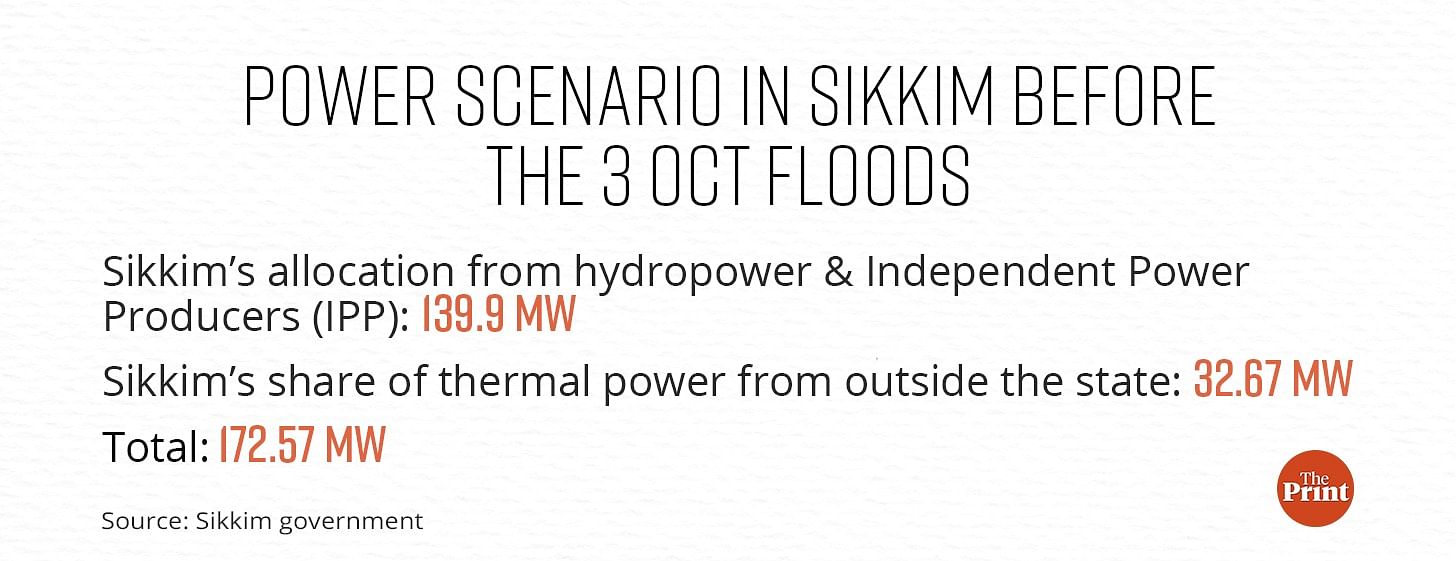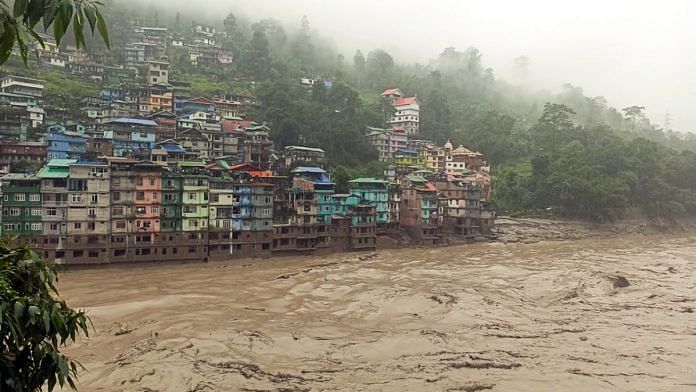Gangtok: From being a power surplus state, Sikkim has now been forced to purchase power from neighbouring states to meet its requirements, ThePrint has learnt. This comes after a devastating glacial lake outburst flood (GLOF) in South Lhonak Lake on 3 October damaged three of its big hydropower projects.
With winter months approaching, power demand is expected to shoot up.
The damage inflicted by the GLOF led to a loss of around 77 MW of hydropower — the state’s share from these three plants — officials from the state’s power department told ThePrint. The small northeastern state’s anticipated power demand is likely to reach 140 MW during peak hours in the winter season while the non-peak demand is anticipated to reach 95-100 MW.
In order to avoid a crippling shortage during the winter months — because of the loss of 77 MW — Sikkim has entered into power tie-ups with neighbouring states, officials said.
The state has for a long time enjoyed a power surplus status, with hydropower export being a major source of revenue generation. Sikkim’s power department had earned revenue of Rs 165 crore by selling surplus power outside the state in the 2022-23 fiscal, an official said.
“As against the anticipated power demand of 140 MW, post the flood and damage to the three hydropower plants, Sikkim’s allocated share stands at 77 MW. We had not anticipated this while tying up for additional power to meet our winter requirement, when there’s a sharp rise in demand,” a power department official told ThePrint.
On 3 October, the South Lhonak glacial lake burst its banks, causing deadly floods and damaging the state-run Sikkim Urja’s 1200 MW Teesta Stage-III project, NHPC’s 510 MW Teesta-V project, and an independent power producer’s (IPP’s) 96 MW Dikchu project. The Teesta-III project’s Chungthang dam got washed away in the flood, as were the five spillways of the Teesta-V dam.
The Dikchu hydropower plant also got submerged in the floodwater. Power generation has been stopped at all three plants since 4 October.

While the state’s share from the Teesta-V project was 67 MW, it was 10 MW from the Dikchu hydel power plant. In the Teesta-III project run by Sikkim Urja, the state government pledged the royalty from its 12 percent share of free power to Power Finance Corporation to repay its loan and interest in lieu of over Rs 1,800 crore it had taken to develop the project.
Also Read: What’s a ‘moraine’, how its fall caused Sikkim’s South Lhonak Lake flood and why threat remains
Why Sikkim could face outages despite being power-surplus
There are 19 small and big hydropower plants in Sikkim, with an installed capacity of 2,331 MW.
Prior to the floods, the state’s total power share allocation was 172.57 MW. Of this, 139.9 MW was from hydropower plants run by the state entities, NHPC, and IPPs while the remaining 32.67 MW was sourced from thermal power plants outside the state, the senior power department official quoted earlier said.

Independent Power Producers (IPPs) are private entities that own and or operate power-generating facilities to sell to other utilities, central government buyers, and end users.
However, Sikkim, despite being a power-surplus state, has to source thermal power as the availability of surplus hydropower is limited to six months between April to September-October.
“During the lean winter season (November-March), water is less in the river and hydropower is not available round the clock. Generation falls drastically because of the decrease in water level. That is when Sikkim buys power from outside,” the power department official said.
But after the 3 October floods, the state government has been left to fend for itself.
As winter draws near, time is running out. The base load of the state during the winter is anticipated to be 95 MW, with the peak load shooting to around 140 MW, a Sikkim government official said.
“As against this, we have 77 MW currently. We have now arranged for power otherwise Sikkim would have had no option but to overdraw power to the tune of 70 MW to 80 MW. The state would have to shell out a penalty for overdrawing because its scheduled draw was 32 MW. The market rate of power during the winter season is generally around Rs 10/unit, which is very high and it would have had financial implications for the state,” the official added.
(Edited by Uttara Ramaswamy)
Also Read: How an alert ITBP jawan on duty 8 km away from South Lhonak lake raised 1st flood alarm in Sikkim



